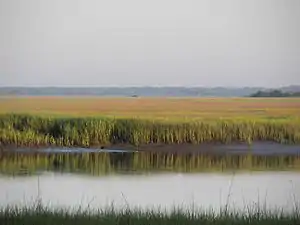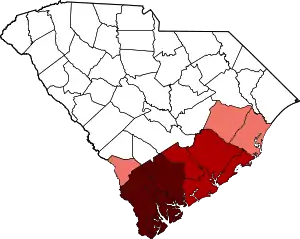
The Lowcountry (sometimes Low Country or just low country) is a geographic and cultural region along South Carolina's coast, including the Sea Islands. The region includes significant salt marshes and other coastal waterways, making it an important source of biodiversity in South Carolina.
Once known for its slave-based agricultural wealth in rice and indigo, crops that flourished in the hot subtropical climate, the Lowcountry today is known for its historic cities and communities, natural environment, cultural heritage, and tourism industry. Demographically, the Lowcountry is still heavily dominated by African American communities, such as the Gullah/Geechee people.[1]
As of the 2020 census, the population of the Lowcountry was 1,167,139.
Geography

The term "Low Country" originally referred to all of the state below the Fall Line, or the Sandhills, which run the width of the state from Aiken County to Chesterfield County. The Sandhills, or Carolina Sandhills, is a 15–60 km wide region within the Atlantic Coastal Plain province, along the inland margin of this province. The Carolina Sandhills are interpreted as eolian (wind-blown) sand sheets and dunes that were mobilized episodically approximately 75,000 to 6,000 years ago.[2] Most of the published luminescence ages from the sand are coincident with the last glaciation, a time when the southeastern United States had colder air temperatures and stronger winds. The area above the Sandhills is known as "Upstate" or "Upcountry". These areas are different in geology, geography, and culture.
There are several variations on the geographic extent of the "Lowcountry" area. The most commonly accepted definition includes Charleston, Dorchester, Beaufort, Georgetown, Colleton, Hampton, Berkeley, Jasper, and Williamsburg Counties, often described as the area encompassing the basins of Cooper River, Santee River, ACE (Ashepoo-Combahee-Edisto), Winyah Bay, and Savannah River.[3][4][5][6] Some include Marion and Horry Counties.[7] Dillon County is included in the Lowcounty by the largest group of healthcare executives in the state.[8]
Four counties are covered by the Lowcountry Council of Governments, a regional governmental entity charged with regional and transportation planning,[9] and are the ones included in the South Carolina Department of Parks, Recreation, and Tourism's "Lowcountry and Resort Islands" area.[10] The area includes the Hilton Head Island-Bluffton-Beaufort, SC Metropolitan Statistical Area.
Technically, the Lowcountry is synonymous with the areas with a large population of Gullah Geechee peoples of the region. Gullah Geechee people have traditionally resided in the coastal areas and the sea islands of North Carolina, South Carolina, Georgia and Florida—from Pender County, North Carolina, to St. Johns County, Florida.[11][12][13]
Tourism
The tourism industry has been a vibrant part of the region's economy since the beginning of the 20th century.[14] The tourism commission advertises both nature-based tourism and historic sites.[15][16] The pressure of the tourism industry on the coast both encroaches on marshland and places pressure on African American communities.[1][17][16]
The industry tends to emphasize the Gullah Geechee cultural tradition as part of the Gullah/Geechee Cultural Heritage Corridor.[13] Important to this cultural tradition are traditional sweetgrass baskets.[18] But harvesting natural sweetgrass is under pressure from both development and overharvesting.[13] Mary Jackson was awarded a MacArthur Fellowship for her work making sweetgrass baskets.
See also
References
- 1 2 Moore, Dasia (September 3, 2020). "The environmental racism threatening South Carolina's Black communities". Quartz. Retrieved March 27, 2022.
- ↑ Swezey, C.S., Fitzwater, B.A., Whittecar, G.R., Mahan, S.A., Garrity, C.P., Aleman Gonzalez, W.B., and Dobbs, K.M., 2016, "The Carolina Sandhills: Quaternary eolian sand sheets and dunes along the updip margin of the Atlantic Coastal Plain province, southeastern United States": Quaternary Research, v. 86, p. 271-286; doi:10.1016/j.yqres.2016.08.007
- ↑ "Lowcountry Initiative - Conservation Easements".
- ↑ "Ernest F. Hollings Ace Basin National Wildlife Refuge".
- ↑ "Ducks Unlimited Lowcountry Initiative - Focus Areas and Protected Lands" (PDF). Ducks Unlimited.
- ↑ "What Exactly is Lowcountry Cooking?". August 19, 2015.
- ↑ "Land Conservation - Lowcountry - Strategy and Guidelines".
- ↑ "About Us".
- ↑ Lowcountry Council of Governments Archived September 5, 2015, at the Wayback Machine official website.
- ↑ Tourism Regions (map) at South Carolina Department of Parks, Recreation, and Tourism official website.
- ↑ "Gullah Geechee Cultural Heritage Corridor Commission". Retrieved May 7, 2023.
- ↑ "Where to Go – Gullah Geechee Cultural Heritage Corridor Commission".
- 1 2 3 Hurley, Patrick T.; Halfacre, Angela C. (August 1, 2011). "Dodging alligators, rattlesnakes, and backyard docks: a political ecology of sweetgrass basket-making and conservation in the South Carolina Lowcountry, USA". GeoJournal. 76 (4): 383–399. doi:10.1007/s10708-009-9276-7. ISSN 1572-9893. S2CID 154309657.
- ↑ "Lowcountry Tourism | Lowcountry Digital Library". Retrieved March 27, 2022.
- ↑ "South Carolina Lowcountry – The Lowcountry Region". South Carolina Lowcountry. April 11, 2011. Retrieved March 27, 2022.
- 1 2 Faulkenberry, Lisa; Coggeshall, John; Backman, Kenneth; Backman, Sheila (October 15, 2007). "A Culture of Servitude: The Impact of Tourism and Development on South Carolina's Coast". Human Organization. 59 (1): 86–95. doi:10.17730/humo.59.1.353730461t724j02. ISSN 0018-7259.
- ↑ "Climate change is having an adverse effect on South Carolina's Low Country". NPR.org. Retrieved March 27, 2022.
- ↑ Rosengarten, Dale; Museum, McKissick (April 20, 2022). Row Upon Row: Sea Grass Baskets of the South Carolina Lowcountry. Univ of South Carolina Press. ISBN 978-1-64336-274-8.

